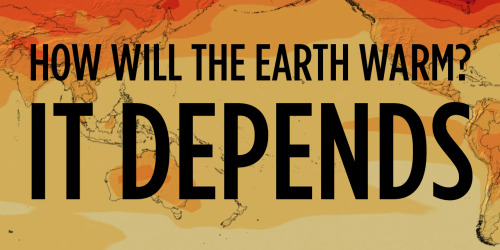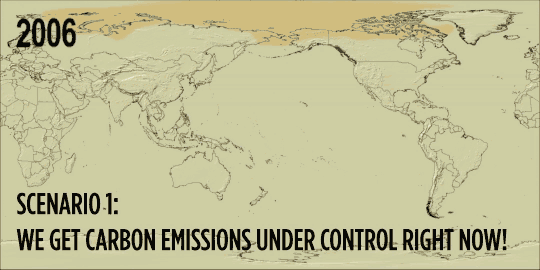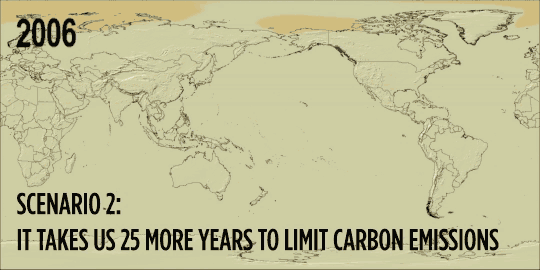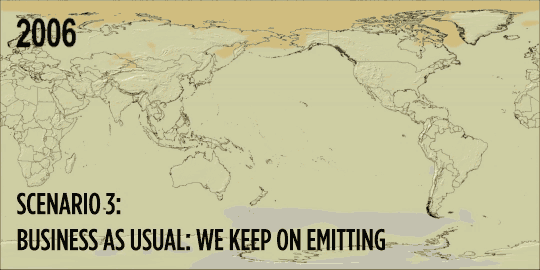“About 3 Billion People Around The World — Mostly In Africa And Asia, And Mostly Very Poor —

“About 3 billion people around the world — mostly in Africa and Asia, and mostly very poor — don't have access to modern energy and still cook and heat their homes by burning coal, charcoal, dung, wood, or plant residue indoors. These homes often have poor ventilation, and the smoke can cause a horrible array of respiratory diseases, including lung cancer... Indoor air pollution gets surprisingly little attention for such a lethal public health problem. It kills more people each year than HIV/AIDS and malaria combined, but few countries treat it as a crisis on the same level.” - Vox
More Posts from Envirographs and Others





As governments discuss climate change in Paris, they’ll be referring to the dire predictions of climate scientists. Here are three visualizations of possible futures based on detailed climate models and summed up by the United Nations’ Intergovernmental Panel on Climate Change (IPCC) in their 2013 report. The deeper the red - the hotter things are getting.
The message is clear: we better act fast.
How did they come up with these models? Read or listen to Nell Greenfieldboyce’s story.
Image Credit: NASA’s Scientific Visualization Studio and NASA Center for Climate Simulation


CO2 emissions from coal, oil, and gas worldwide - the Washington Post
I'm back...
I apologize for my 5 months hiatus. I intend to divert my attention back to Envirographs, to continue using graphs and maps to explore environmental problems, trends and solutions.


Preparedness for climate change (top) and coastal flooding (bottom), from States at Risk

The United States-Mexico border (solid black line); observed range of adult male jaguar ‘Macho B’ from May 2006 to April 2007 (white oval); important cross-border corridors for jaguars and other wildlife (heavy white double-arrows); 4- to 5-m-tall steel border fences existing or under construction as of 2007 (solid white lines); increased border security [vehicle barriers, chain-link fences, virtual fencing, surveillance towers,agent patrols] (white dashed lines); funneled undocumented immigrant and resulting law enforcement traffic (black arrows).
Given the current administration’s promise to build a border wall along the entire US-Mexico border, worth considering this 2008 study on the potential impacts of a border fence on Jaguars in the borderlands.
Jaguars (Panthera onca) are typically associated with the rain forests of Central and South America; however, the species historically ranged into the arid southwestern United States... as global climate trends change toward hotter, drier environments, Jaguars living in the borderlands may become even more important to the survival of the species. Effective conservation of jaguars will require maintaining sufficient core and connective habitats to avoid population fragmentation and thus reduce the probability of extinction.
The Secure Fence Act of 2006 mandated the United States Department of Homeland Security to physically separate Mexico from the southwestern United States with steel fences 3–4 m high across 1,280 km of the United States–Mexico border, including ∼70% of the Arizona border... The border fence may effectively partition the already small, northernmost population of jaguars and isolate jaguars in the United States from the larger source population in northwestern Mexico.
Emil B. McCain, Jack L. Childs; Evidence of Resident Jaguars (Panthera onca) in the Southwestern United States and the Implications for Conservation. J Mammal 2008; 89 (1): 1-10. doi: 10.1644/07-MAMM-F-268.1

While the coal industry is fighting Clean Water Act protections for rivers and streams from mountaintop removal mining (MTR), this 2011 poll of residents in Kentucky, Virginia, West Virginia and Tennessee found strong support.
Other interesting results:
57% of voters oppose MTR; 20% support
64% of Democrats, 60% of independents and 51% of Republicans oppose MTR

A recent study looked at the demographics of an elephant population in Samburu, Kenya, and the impact of poaching. This graph shows the annual PIKE, or Proportion of Illegally Killed Elephants. PIKE is calculated as the number of illegally killed (poached) elephant carcasses divided by the total number of elephant carcasses discovered that year. The graph shows a recent dramatic increase in poaching.
The authors state:
Illegal human killing caused over half the recorded mortality in the Samburu elephants over the age of 9 (and indirectly caused the deaths of all victim’s dependent calves under 2 years). The high illegal killing in the latter part of the study had serious ramifications for the structure and organization of the population... the illegal killing appeared to select adult individuals in Samburu and particularly males resulting in increasing skew in the sex ratio over the course of the fourteen year study. Social disruption also resulted, with numerous well known and stable family groups being completely lost (i.e. no surviving breeding females) causing increased numbers of unaffiliated juveniles (orphans)
According to the New York Times, the recent spike in poaching, the greatest in decades, is driven by rising demand for ivory in Asia.

As Trump casts himself as a savior for the coal industry, the red states that voted for him are adding most of the nation’s clean energy,
From JUSTIN GILLIS and NADJA POPOVICH in the New York Times:
The five states that get the largest percentage of their power from wind turbines — Iowa, Kansas, South Dakota, Oklahoma and North Dakota — all voted for Mr. Trump. So did Texas, which produces the most wind power in absolute terms. In fact, 69 percent of the wind power produced in the country comes from states that Mr. Trump carried in November... These red states are not motivated by a sudden desire to reduce greenhouse gas emissions... their leaders see tapping the wind, and to a lesser degree the sun, as an economic strategy. The clean energy push allows their utilities to lock in low power prices for decades, creates manufacturing jobs, puts steady money in the hands of farmers who host wind turbines, and lures big employers who want renewable power.
A visual exploration of environmental problems, movements and solutions.
151 posts


